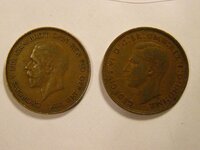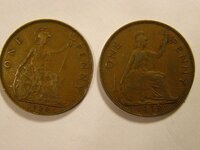Navigation
Install the app
How to install the app on iOS
Follow along with the video below to see how to install our site as a web app on your home screen.
Note: This feature may not be available in some browsers.
More options
You are using an out of date browser. It may not display this or other websites correctly.
You should upgrade or use an alternative browser.
You should upgrade or use an alternative browser.
Penny not cent
- Thread starter Yinzi50
- Start date
The_EE
Bronze Member
I found a 1940 in a roll of halves last week, I bet I will find more.
enamel7
Gold Member
- Apr 16, 2005
- 6,383
- 2,545
- Detector(s) used
- Garrett AT Gold
- Primary Interest:
- All Treasure Hunting
Yepper that's a penny. Contrary to most postings, we have a cent, not a penny.
HH
enamel7
HH
enamel7
Captaindoodle
Sr. Member
- Feb 10, 2008
- 321
- 5
Nice finds 
Generic_Lad
Bronze Member
- Jul 23, 2010
- 1,373
- 276
- Detector(s) used
- Garrett Ace 250, Bounty Hunter Quick Draw
- Primary Interest:
- Other
Yep, nice examples of pennies. Sadly I don't think that there are any rare major varieties for that year (many pennies, particularly Victorian bun-head pennies have multiple varieties some of which are very desirable for collectors of British coins) and so they aren't worth that much but I've always liked the large pre-decimal pennies.
Generic_Lad
Bronze Member
- Jul 23, 2010
- 1,373
- 276
- Detector(s) used
- Garrett Ace 250, Bounty Hunter Quick Draw
- Primary Interest:
- Other
hokiemojo said:i don't understand the difference. do you mind elaborating?
The difference between cent and penny?
Cent comes from 1/100. Usually in use (in various forms) for a decimal system where 100 cents equal 1 of the large units (dollars, pounds, yen, etc.)
Penny comes from pre-decimal system and usually refers to weight. For example, there were 240 English pennies to the pound.
The pre-decimal British system went as follows:
12 pence to the shilling and 20 shillings to the pound.
Today, all currencies are decimal and the penny name on some of them are simply holdovers from the pre-decimal days.
Generic_Lad said:The difference between cent and penny?
Cent comes from 1/100. Usually in use (in various forms) for a decimal system where 100 cents equal 1 of the large units (dollars, pounds, yen, etc.)
Penny comes from pre-decimal system and usually refers to weight. For example, there were 240 English pennies to the pound.
The pre-decimal British system went as follows:
12 pence to the shilling and 20 shillings to the pound.
Today, all currencies are decimal and the penny name on some of them are simply holdovers from the pre-decimal days.
+1
Very nice
yyznick
Jr. Member
- Jan 18, 2012
- 25
- 2
- Primary Interest:
- Other
Generic_Lad said:The difference between cent and penny?
Cent comes from 1/100. Usually in use (in various forms) for a decimal system where 100 cents equal 1 of the large units (dollars, pounds, yen, etc.)
Penny comes from pre-decimal system and usually refers to weight. For example, there were 240 English pennies to the pound.
The pre-decimal British system went as follows:
12 pence to the shilling and 20 shillings to the pound.
Today, all currencies are decimal and the penny name on some of them are simply holdovers from the pre-decimal days.
Learn something new everyday!
Nice finde! I found a couple british pennies in the half dollars box, made me want to buy some so I was actually able to buy a nice variety on ebay uk for something like $7 total for 20-30 pennies. All are from the late 1800's some are the younger queen, some older.
Generic_lad: where would I look to find a listing of varieties? I was just giving away some of the pennies, but if I should look for varieties first I will...
Generic_lad: where would I look to find a listing of varieties? I was just giving away some of the pennies, but if I should look for varieties first I will...
Stang1968
Full Member
- Dec 14, 2010
- 168
- 0
- Primary Interest:
- All Treasure Hunting
Good lord it must've been hard to make change in those days.Generic_Lad said:hokiemojo said:i don't understand the difference. do you mind elaborating?
The difference between cent and penny?
Cent comes from 1/100. Usually in use (in various forms) for a decimal system where 100 cents equal 1 of the large units (dollars, pounds, yen, etc.)
Penny comes from pre-decimal system and usually refers to weight. For example, there were 240 English pennies to the pound.
The pre-decimal British system went as follows:
12 pence to the shilling and 20 shillings to the pound.
Today, all currencies are decimal and the penny name on some of them are simply holdovers from the pre-decimal days.
Generic_Lad
Bronze Member
- Jul 23, 2010
- 1,373
- 276
- Detector(s) used
- Garrett Ace 250, Bounty Hunter Quick Draw
- Primary Interest:
- Other
conpewter said:Nice finde! I found a couple british pennies in the half dollars box, made me want to buy some so I was actually able to buy a nice variety on ebay uk for something like $7 total for 20-30 pennies. All are from the late 1800's some are the younger queen, some older.
Generic_lad: where would I look to find a listing of varieties? I was just giving away some of the pennies, but if I should look for varieties first I will...
http://www.coinsgb.com/Victoria/6-Penny.html
At the bottom are some lists for the most common ones. If you really want to get into British penny collecting there is the Freeman guide to Victorian Pennies but it is quite expensive ($50-100) since it has been out of print for a while. Though I myself don't have a copy.
Good lord it must've been hard to make change in those days.
While undoubtedly it would have been harder, the coinage system was set up to handle the weird system (which is why you have weird things like sixpence and threepence which make no sense to us thinking in a decimal system)
You'd have the farthing which is 1/4th of a penny (along with fractional farthings in use in the colonies in the 1800s), the half-penny, worth 1/2 a penny, and the penny. But then you'd have the threepence which is a quarter of a shilling and the sixpence, worth half a shilling. You'd then have the shilling (worth 12 pennies), the Florin (an early step towards decimalization created in the Victorian era) at 2 shillings, the half crown worth 2 and a half shilling (30 pence or 2 shillings 6 pence), and the crown worth 5 shillings or a quarter of a pound. The pre-decimal coins were fairly huge, a farthing is about the same size as a US penny, the half-penny about the same size of a quarter and a penny the size of a half-dollar. The silver threepence was a tiny coin, a bit larger than a half dime, but it was replaced starting in 1937 (though both circulated at the same time) with a large, thick multisided brass coin. The sixpence was a bit bigger than the dime, about the size of a penny or so. The shilling was about the size of a US quarter. The Florin was about the size of a half dollar, and the crown was a bit bigger than a US silver dollar.
Since for most of its life the pound was a very high valued currency (about 4-5 dollars per pound just using straight exchange rate and that was back before inflation ate away most of the dollar's purchasing power) there wouldn't have been that much change to be made.
However, this weird system does explain why we all learned our multiplication tables up until 12 in grade school (though decimalization had long since happened when I was in school)
Top Member Reactions
-
 3301
3301 -
 1910
1910 -
 1905
1905 -
 1134
1134 -
 1097
1097 -
 863
863 -
 858
858 -
 844
844 -
 831
831 -
 747
747 -
 717
717 -
 548
548 -
 546
546 -
 507
507 -
 439
439 -
 438
438 -
E
414
-
 405
405 -
 393
393 -
 382
382
Users who are viewing this thread
Total: 2 (members: 0, guests: 2)









